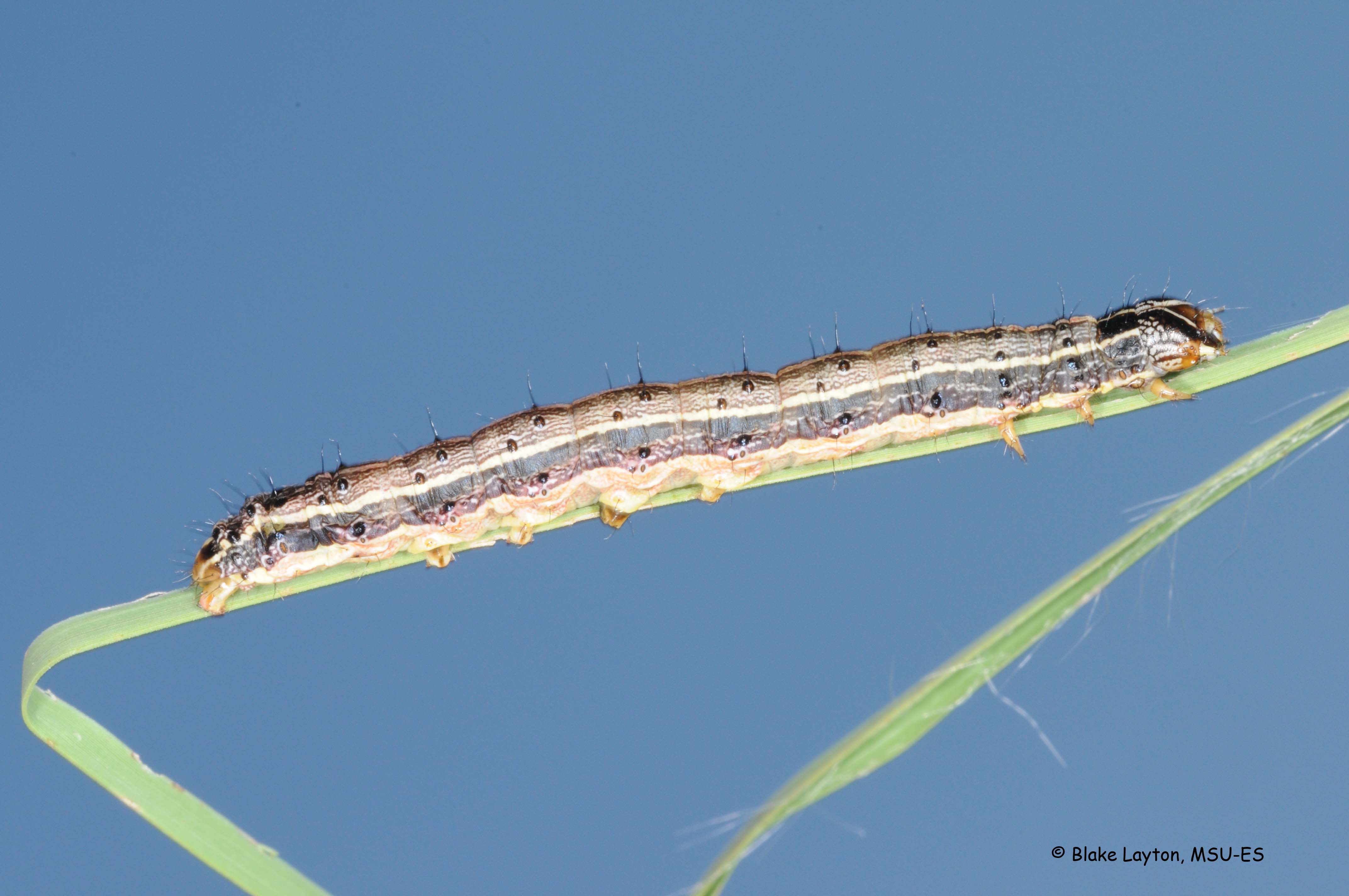Fall Armyworm, Vol. 10, No. 14
Spodoptera frugiperda
Order: Lepidoptera
Family: Noctuidae

 Fall armyworms are the most damaging insect pests of Bermudagrass hayfields, and many hay producers have had the disappointing experience of “losing a cutting”, to these ravenous caterpillars. Undetected infestations can eat a lot of grass in a surprisingly short time. A field that looks beautiful and almost ready to cut on Thursday morning may be nothing but stems by Saturday.
Fall armyworms are the most damaging insect pests of Bermudagrass hayfields, and many hay producers have had the disappointing experience of “losing a cutting”, to these ravenous caterpillars. Undetected infestations can eat a lot of grass in a surprisingly short time. A field that looks beautiful and almost ready to cut on Thursday morning may be nothing but stems by Saturday.
Fall armyworms do not overwinter in the state, but moths migrating from more southern regions return each year to produce several generations, with numbers increasing each generation. Some fall armyworms are present every year, especially in southern Mississippi, but heavy outbreaks sporadically occur, resulting in damaging infestations earlier in the year and/or farther north and the need for more insecticide treatments throughout the state. 2021 saw the heaviest populations in recent decades. It is too soon to know what will happen this year, but with fall armyworms, it is best to prepare for the worst.
Hay fields are not all they damage. Fall armyworms like bermudagrass wherever they can find it and will also damage turfgrass in home lawns, sports fields, golf courses, commercial landscapes and elsewhere. Although they prefer bermudagrass, they will also attack other grasses, such as Bahia grass hayfields, early planted wheat, and winter forage grasses, and even other turfgrasses, especially in heavy outbreak years.
Control: To successfully control fall armyworms and prevent excessive damage you must detect infestations early and have your spray equipment ready to go. In hayfields, treatment is recommended when infestation levels exceed three caterpillars that are ½ inch or longer per square foot.
See Extension Publication 2717, Fall Armyworms in Hayfields and Pastures,
for a list of recommended insecticides, application rates and pre-grazing intervals. Information on biology, scouting and thresholds is also included. Hay producers also need to be aware of and alert for bermudagrass stem maggots, which can require treatment earlier in the hay production cycle.
See Page 8 of Extension Publication 2331, Control Insect Pests in and around the Home Lawn.
for information on do-it-yourself armyworm control in home lawns. For smaller lawns, one of the cheapest, easiest, and most convenient ways to treat is to use one of the ready-to-use hose-end applicators that contains a pyrethroid insecticide, such as permethrin, cyfluthrin, bifenthrin, or cyhalothrin. For large lawns, one of the easiest and most convenient ways to treat is to hire a licensed commercial applicator. But if you have the right equipment and know how to use it, you can do your own spraying.
See Pages 12 and 13 of Extension Publication 1858, Insect Control in Commercial Turf, for information on fall armyworm control in sports fields, golf courses and other commercial turf. Before treating sports fields be sure to verify the product you plan to use is specifically labeled for use on sports fields and carefully check the re-entry interval. It is especially important to pay attention to label restrictions and REIs in sports fields because athletes frequently come into close contact with the turfgrass.
Blake Layton, Extension Entomology Specialist, Mississippi State University Extension Service.
The information given here is for educational purposes only. Always read and follow current label directions. Specific commercial products are mentioned as examples only and reference to specific products or trade names is made with the understanding that no discrimination is intended to other products that may also be suitable and appropriately labeled.
Bug’s Eye View is now on Facebook. Join the Bug's Eye View Facebook group here.

